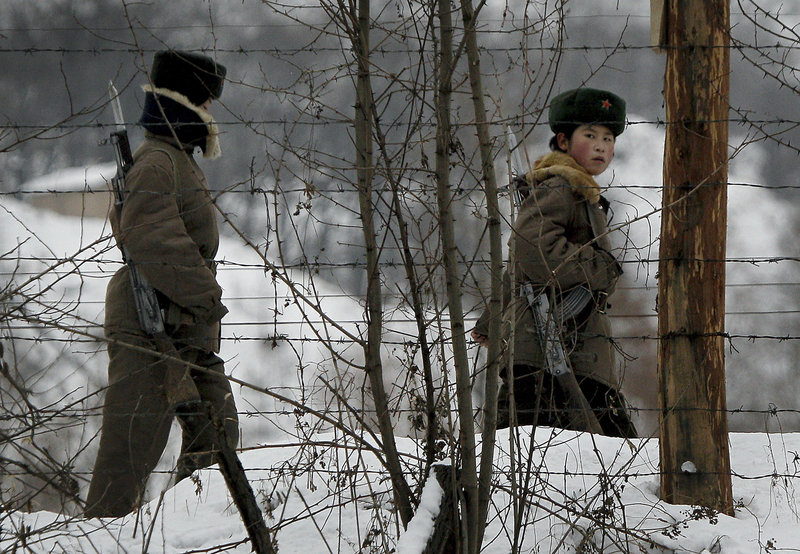SEOUL, South Korea – Six days after a North Korean artillery bombardment killed four people and heightened fears of an all-out conflict, South Korean President Lee Myung-bak took responsibility for failing to protect the country and said the South will now abandon its longstanding policy of not responding militarily to the North’s hostile acts.
“In the past, North Korea has provoked us on many occasions, but this is the first time they have made a direct attack on South Korean soil,” said Lee, making his first public remarks since the crisis began last week with the attack on civilian-inhabited Yeonpyeong island. “Launching a military attack on civilians is a crime against humanity, even during wartime.”
Speaking at the Blue House, the presidential palace in Seoul, Lee outlined a series of past provocations from the North stretching back two decades, including the attempted assassination of the South Korean president in Rangoon in 1983, the bombing of a South Korean airliner in 1987, and the sinking of a South Korean warship, the Cheonan, in March.
“Despite all of these provocations,” Lee said, “we tolerated them in the belief that one day North Korea will change, and because of our hope for peace on the Korean Peninsula.”
He said South Korea has continued to engage in talks with Pyongyang and has given humanitarian assistance to the economically troubled country, but North Korea kept up its pursuit of nuclear weapons and continued its attacks.
Now, Lee said, “South Koreans realize that tolerance and generosity bring more provocation.” He said that South Korea will strengthen its military capability and will “make North Korea pay the due price by all means for its provocation from now on.”
While Lee did not specify what form any future retaliation would take, his statement seemed to reflect a shift from the South’s past policy of tolerance.
“I think it’s a turning point for South Korean government policy dealing with North Korea,” Baek Seung-joo, a researcher at the Korea Institute for Defense Analysis, said after the speech. “With the nation’s support, Lee will make sure any further provocation is met with military action.”
After the attack, the United States and South Korea announced plans for a four-day joint military exercise, which began Sunday.
The attack on the island exposed weaknesses in the South Korean defense system, which the government has in recent days promised to mend. The military announced plans to upgrade its weaponry and to give front-line troops more flexible rules of engagement to more effectively respond to a future attack.
When the island came under bombardment, South Korean troops took 13 minutes to return artillery fire — and by that time, scores of houses and buildings were already destroyed.
The attack has also become a political crisis for the government, forcing the resignation of the defense minister, who took the blame for the delayed response. Lee has also come under criticism for not taking a tougher line against the North.
The crisis began Nov. 23, when North Korea fired nearly 200 artillery rounds onto the small island of Yeonpyeong, which lies close to the two countries’ disputed maritime border.
The artillery barrage, which demolished scores of houses and other structures, was considered more provocative than past North Korean actions — such as the sinking of a South Korean warship in March — because the island is inhabited by civilians.
Over the weekend, North Korea seemed to offer an apology of sorts for the deaths of two civilians, saying, “If that is true, it is very regrettable.” But the North blamed Seoul’s military for putting civilians in the way of its artillery as “human shields.”
The military exercises were intended “to send a very powerful signal of deterrence,” Adm. Mike Mullen, chairman of the Joint Chiefs of Staff, said in a television interview on CNN. The drills are taking place about 75 miles south of Yeonpyeong island.
But North Korea has responded that it will turn the entire area into “a merciless shower of fire” if its territorial waters are violated.
The exercises today were to include a live-fire drill by multiple aircraft from the nuclear-powered USS George Washington, which carries 6,000 sailors and 75 fighter jets. South Korean news media quoted a Korean military official as saying the aircraft would fire on mock targets in the water, while South Korean Aegis destroyers will practice detecting and destroying targets.
The crisis has placed intense pressure on China to try to rein in its erratic and unpredictable North Korean ally. After refusing to criticize Pyongyang for the attack, China scrambled its diplomats over the weekend, including sending Dai Bingguo — China’s equivalent of the national security adviser — to Seoul for talks.
On Sunday, China called for an emergency meeting of delegates to the long-disbanded six-party talks, which include the United States, North and South Korea, China, Japan and Russia.
But South Korean officials said they told the Chinese privately that they were not interested in talks at the moment, and some expressed surprise that China made the announcement publicly.
Send questions/comments to the editors.



Success. Please wait for the page to reload. If the page does not reload within 5 seconds, please refresh the page.
Enter your email and password to access comments.
Hi, to comment on stories you must . This profile is in addition to your subscription and website login.
Already have a commenting profile? .
Invalid username/password.
Please check your email to confirm and complete your registration.
Only subscribers are eligible to post comments. Please subscribe or login first for digital access. Here’s why.
Use the form below to reset your password. When you've submitted your account email, we will send an email with a reset code.